
The lumbar spine is most susceptible to stress, because it is affected by the entire body weight. Moreover, it is very mobile.
If the vertebral corset is not sufficiently developed, then the pressure on the intervertebral discs increases several times. Namely, they are responsible for the mobility and flexibility of the back.
So low back osteochondrosis, which occurs for various reasons, is a fairly common disease of the musculoskeletal system.
It develops gradually and a person may simply not pay attention to its first signs. However, it requires serious treatment.
How the disease develops and its causes
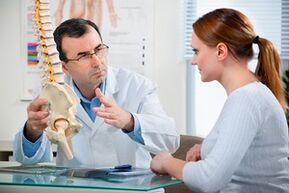
In the lower back, the sacrum and the thoracic vertebra are connected. There are many factors provoking lumbar osteochondrosis. The main thing is considered to be incorrect and excessive load on the back.
In the process of the disease, glycoproteins are broken down, affecting the connective tissue of the joints and making it elastic. It affects the bone and cartilaginous structures of the spine.
The intervertebral discs contain a gel-like substance that dries up with lumbar disease. They are depleted, then they become flat. Due to this, the spine loses its amortization function, its segments come closer together, and the nerve roots and blood vessels are clamped.
At the same time, there is a cracking of the fibrous ring, and in some cases it may rupture, which leads to the formation of a hernia. All this provokes swelling, lower back pain.
The muscular frame protects the spine from negative influences and is responsible for correct posture. Problems with him can also lead to the development of osteochondrosis in the lumbar spine.
There are other reasons for the onset of the disease:
- Congenital changes, loose disc structure.
- Stressful state.
- Infectious diseases in bone and cartilage tissues.
- Inconvenient shoes.
- Back injury.
- Inflammation of the joints.
Lifestyle, profession, age are also important here. The maximum load on the spine occurs in the sitting position. Therefore, people who spend most of their time in a sitting position are at risk.
These can be office workers, drivers. Low physical activity is also not the best way to affect the lumbar spine. As a result, the musculoskeletal system becomes weaker.
The influence on the spine, and especially the lower back, weight lifting also plays a significant role. This is due to professions such as loader, construction worker, waiter or professional athlete, that is, people who are constantly experiencing stress on their backs.
Osteochondrosis can also occur during pregnancy in women. If there is a curvature of the spine, then increased pressure on the lumbar spine and uneven weight distribution also leads to illness.
In the same way, it affects the occurrence of osteochondrosis and flat feet. The arch of the foot loses its function, and all the load when walking goes to the spinal column. Excess weight also plays a negative role. The disease can be a complication after osteomyelitis, tuberculosis.
Unfavorable factors in lumbar osteochondrosis are also improper sleep patterns, nutrition, disturbed metabolic processes in the body, or diseases of internal organs:
- gastrointestinal tract and liver;
- small pelvis;
- central nervous system.
People of different ages are susceptible to the disease.
Lumbar osteochondrosis symptoms

One of the first manifestations is usually pain and discomfort in the lumbar spine. At the same time, it can be difficult to bend, turn, bend the big toe. Sometimes there is a feeling of coldness, or, conversely, a burning sensation in the back.
As a rule, symptoms appear after physical exertion, hypothermia, or being in an uncomfortable position for a long time. They often go away after a short rest. In the acute phase, they can have the character of a lumbago and are aggravated by movement, coughing, sneezing.
Muscle spasm in the back does not allow a person to take a position, which will lead to increased pain, this happens reflexively. In addition to these symptoms, there are the following signs:
- Fatigue and weakness.
- Increased sweating.
- Sleep disturbances.
- Varicose veins.
- Tingling sensation and aches in the limbs.
- Violation of tendon reflexes.
Due to spasms, the legs can freeze, as well as beak-like growth and a decrease in the height of the discs.
The sciatic nerve, which is formed by the sacral roots of the spinal cord, can also suffer from osteochondrosis of the lower back. This is manifested by pain that radiates to the leg or swelling.
If the arteries or vessels are compressed, this is characterized by loss of sensitivity, but the pains are mild. They are localized in the lower back, respond in the hips, buttocks. The pain syndrome also differs in the time of occurrence. Aching sensations usually appear in the morning, over time they can become permanent and not dependent on movement.
Complications of osteochondrosis of the lumbar spine
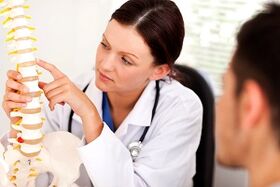
The instability of the discs and the fact that they do not fix the spine leads to a displacement of the lumbar spine. This also affects the work of internal organs. Osteochondrosis is complicated by problems in the genitourinary system, a feeling of discomfort in the kidney area.
In women, menstrual irregularities are possible with it, in men problems in the genital area. Another symptom of the disease is flaky and dry skin in the affected areas.
If you do not deal with the treatment of osteochondrosis, it can lead to spinal stroke and other unpleasant consequences. Protrusion of the discs is possible when they stretch and go beyond the boundaries of the vertebrae. Cartilage atrophy also manifests itself. During this period, the pain can subside due to the growth of bone tissue.
Spondyloarthrosis is sometimes isolated as a form of osteochondrosis, but more often it is considered a complication of it. With it, bone spike-like growths are formed on the spine. They are localized, pain is present in the lumbar region and does not spread to other parts of the body.
Another consequence is foot paresis. In the lower back, unpleasant sensations arise, spreading to the area under the knee and further, which causes dysfunction of the ankle joint. All of these can contribute to disability.
Diagnostics of the osteochondrosis of the lumbar spine

There are several types of studies that a doctor can prescribe for symptoms of lumbar osteochondrosis:
- Plain X-ray (spondylography), which shows the state of each vertebra separately, intervertebral discs and bone canals.
- Myelography is a more complex type of diagnosis. To carry it out, a coloring liquid is injected into the spinal canal. It helps to find spinal hernias.
- A similar procedure is discography, but with it, fluid is injected into the spinal disc.
- Pneumomyelography. Here, air is used instead of liquid.
Computed tomography can detect compression of the nerve roots, rupture of the disc contour. For more serious cases, an MRI scan may be prescribed.
Disease treatment methods

The main thing is to consult a doctor on time and take treatment seriously. For recovery, you need to make an effort, and to prevent relapse to engage in prevention. Lumbar therapy is a comprehensive approach. Here, the goal is not only to stop the development of the disease and alleviate the symptoms, but also to return the spinal column to the correct position.
The specialist usually prescribes medication using pain relieving and anti-inflammatory drugs: NSAIDs, analgesics. Muscle relaxants are also used. They are aimed at eliminating spasms and discomfort arising from increased muscle tone.
Vasodilator drugs prevent congestion and improve blood circulation. Vitamins and minerals give strength to bones, ligaments and tendons and help remove fluid from the body. They are often prescribed to older people.
Chondroprotectors are also used for treatment, which stop destructive processes in the cartilage tissues and help regeneration. Medicines are administered orally, by injection, or rectally.
Paravertebral blocks are used to quickly relieve pain when the drug is injected into the affected area. But doctors try not to use them often. The body gradually gets used to them and the effectiveness of the impact decreases. In addition, with blockade, muscles can atrophy in the place where the drug is injected.
The complex of treatment also includes exercise therapy. It improves the mobility of the spine and strengthens its muscles. Therapeutic exercises should be selected by a specialist, they are often prescribed after the relief of an acute condition. The load is increased gradually so as not to provoke an exacerbation. Also, gymnastics is used if the patient wore a corset for a long time.
An important part of the treatment is massage. It is aimed at relaxing, relieving pain and spasms. The procedure reduces muscle stiffness and has a good effect on lymph circulation in the tissues around the lumbar region.
Physiotherapeutic methods of treatment are also used. To obtain the desired effect, they must be carried out regularly. Exposure to ultraviolet rays, eliminates spasms, pain affects blood circulation. Laser therapy improves the condition of the spinal roots due to the influence of helium - neon emitters. Spine stretching is also used, as well as the following methods:
- amplipulse;
- phonophoresis;
- diadynamic currents.
However, physiotherapy also has contraindications - these are oncological diseases, diseases of the central nervous system. The main task of all these measures is to return the lumbar spine to the correct anatomical position. As a rule, the course takes on average 2 - 3 months, but it all depends on the specific case.
Operations for osteochondrosis of the lower back
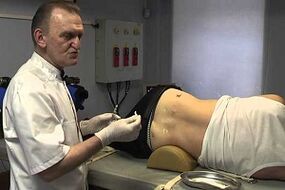
Usually, surgery is resorted to in case of complications, for example, a hernia. Diskectomy is performed, that is, the damaged disc is removed. Microsurgery and endoscopy are less traumatic for the patient, with minimal risks of complications.
During such an intervention, special small-diameter tube expanders are used. Due to this, muscles and ligaments are not damaged. On average, the procedure takes about an hour.
The rehabilitation period takes less time than after a disctomy. But here the assistance of the patient is important, who must strictly follow all the prescriptions of the neurosurgeon.
Additional treatment and prevention measures
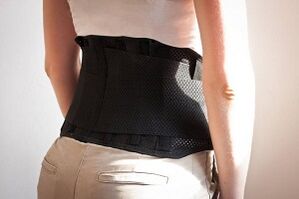
Correction of lifestyle and habits is the first step in the treatment of osteochondrosis of the lumbar spine. Rest and a gentle regimen are important in therapy. It is better to equip the bed with an orthopedic mattress and pillow, it is good to put a special roller under the neck. Avoid being in one position for a long time, hypothermia. It is undesirable to get up abruptly.
Sometimes a special fixation corset is recommended. It keeps your back in the correct position, but not all experts approve of its long-term wearing. This can lead to muscle atrophy in the spine. Most often it is used during an exacerbation of the disease. Corset models are not universal and in every case, only a doctor should select an accessory.
Along with treatment, it is important to follow a number of measures that a doctor may recommend. This is the normalization of weight, proper nutrition is useful here. It is better to eliminate heavy and fatty foods from the diet or reduce its consumption.
It is advisable for osteochondrosis of the lumbar spine to refuse such products:
- Carbonated drinks.
- Salt and sugar.
- Coffee and spices.
- Alcohol.
It is good to introduce into the diet: sea fish, vegetable oils, dairy products, vegetables, fruits and herbs. Jellied meat, jelly, which includes gelatin, will be useful. It is best to steam food.
Walking, swimming are also good for the spine, it will be useful to monitor your posture. These are necessary measures after the end of the course of treatment in order to prevent recurrence of osteochondrosis.
Folk remedies and alternative methods
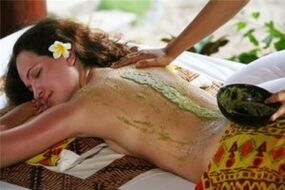
Ointments, compresses are made from plant materials to relieve pain and inflammation. Often used for grinding tincture of red pepper. Liquid ointment can be made with mustard powder, camphor alcohol, and egg whites. It is applied at night.
They make compresses with honey and aloe or cabbage leaves; they also use a decoction of burdock leaves for this. Baths with needles are useful.
There are also alternative treatment options:
- hirudotherapy (use of leeches);
- manual and vacuum therapy;
- acupuncture.
All these funds are best used after consultation with the attending physician.
Self-medication or ignoring the symptoms of osteochondrosis of the lumbar spine can lead to more serious diseases of the spine. Therefore, you should not start an ailment, because the earlier you start treatment, the faster and easier it will be to solve the problem.























